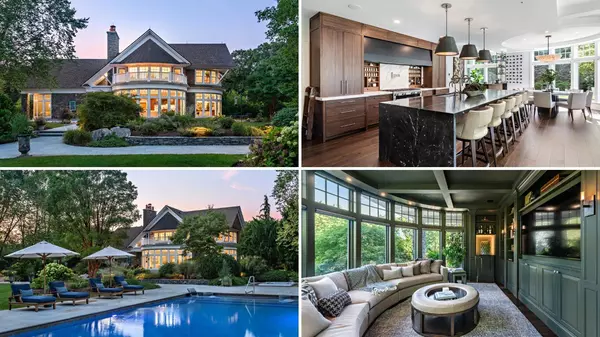Inside Marc Jacobs’ $9.2 Million Frank Lloyd Wright-Designed Home—as he Lifts the Lid on ‘Unexpected’ 4-Year Renovation of the Property

Instagram/Marc Jacobs
Fashion designer Marc Jacobs might be best known for his catwalk creations, but in 2019, he turned his attention to a more ambitious design project: overhauling a $9.17 million Frank Lloyd Wright-designed property in upstate New York that he purchased on something of a whim in 2019.
Jacobs, 61, is now opening up about the lengthy and complex renovations he and husband Charly Defrancesco, 43, have made to the waterfront home, while also explaining his reasons for purchasing the property in the first place.
In the December issue of Vogue, which Jacobs guest-edited, the fashion icon shared a single image of himself posing inside the Rye property—which, according to the notes in his essay about the home, took a mammoth crew of 40 people to capture.
While Jacobs declined to give readers a more in-depth view of his historic home, which is known as the Max Hoffman House, he has been much more open about it on Instagram, where he regularly shares images of himself posing in and around the property.
Located about an hour’s drive from Manhattan and set on a stunning 2 acres of land, the home was originally built in 1955 for auto importer Max Hoffman. The 5,791-square-foot layout features five bedrooms and six baths.

Steve Maxwell

Instagram/Marc Jacobs

Instagram/Marc Jacobs

Instagram/Marc Jacobs
The L-shaped home, which boasts a Japanese garden, has been expanded over the years and underwent an interior renovation in the 1990s.
But by the time Jacobs came to view it in 2019, the house required what he describes as a great deal of “care, attention, and patience.”
Still, despite having decided that he would likely never move out of New York City, the designer says he was overcome with emotion upon seeing the house for the first time, recalling the sense of awe and amazement he experienced at the unique design and stunning grounds.
“I hadn’t even stepped inside, but I could feel it—this place was different, and genuinely one of the coolest houses I had ever seen,” he writes.
The ‘Wright’ stuff
Wright, an American architect known for his innovative designs such as Fallingwater in Mill Run, PA, and the Guggenheim Museum in Manhattan, designed homes that fit into their surroundings. His trademark flourishes included walls of windows and built-in furniture.
Jacobs’ residence is constructed from stone and plaster, with a slate roof and copper trim. Walls of glass frame the serene surroundings.
“The eaves were interrupted by square cutouts revealing the open, expansive sky (also creating incredible architectural shadows on the ground),” Jacobs recalled from his first viewing. “I then noticed the decades-old Japanese maple trees—as if perfectly managed and manicured by nature. They were so different than anything I remembered from growing up in the city.”
Jacobs could recognize the architect’s hallmark design elements showcased in the home, explaining: “The house was living proof of Wright’s hallmark Usonian principle, emphasizing a close connection between a structure and its surrounding environment.”
Though he was “moved” by the design of the home itself, he explains that it was more the feeling of calm he experienced after stepping inside it that won him over.
“Floor-to-ceiling windows opened to the south and east, bathing the space in natural light,” Jacobs gushed. “Outside, the Long Island Sound stretched like a painting—serene, unwavering, majestic.
“I sank into a chair, as if placed on purpose by the window to lure me in, and the view consumed me. In that moment, the city, the noise, the rush, my daily fears and anxieties all melted away. I felt fully present and completely at ease.”

Instagram/Marc Jacobs

Instagram/Marc Jacobs

Instagram/Marc Jacobs

Instagram/Marc Jacobs
‘All my resources, determination, and time’
But the home was not exactly in a turn-key condition.
“The first step was to understand the extent of the decay the house had endured,” as Jacobs recalled. “Immediately noticeable were the sagging eaves, the multitude of leaks from the roof, the dried out, splintered mahogany and the battered exterior woodwork, which had suffered seven decades of winds from the Sound.”
He added, “I knew I could be happy here, but it would take all my resources, determination, and time to make it mine.”
In 2019, the deal was done. Before the work started, he and Defrancesco married at their newly purchased but very much unrenovated residence, in front of the “monumental fireplace” with just 40 guests in attendance.
The couple would later hold another ceremony in New York City, which was attended by hundreds of guests—including the likes of Anna Wintour, Bella Hadid, and Naomi Campbell—but the decision to first marry in their new home cemented its emotional significance in their lives.
Home with history
Built for the Austrian-born automobile dealer who had fled the Nazis, according to Architectural Digest, the waterfront home was also owned by “philanthropist Emily Fisher Landau and, eventually, by Alice and Thomas Tisch,” who sold the property to Jacobs.
AD noted that the property is located in a gated community on Manursing Island, which has a wildlife sanctuary as well as the Playland Amusement Park.
At the time the home came on the market, USA Today noted it had been completely renovated in 1998 and featured one-of-a-kind details, including a “dramatic two-story living room with a suspended second-floor walkway and floating staircase, wood-paneled elevator, guest quarters with a separate entrance, three-bay tiled and heated garage, and a slate roof.”
Prior to buying the Westchester County abode, the fashion mogul had lived in a plush Greenwich Village townhouse.

Instagram/Marc Jacobs

Instagram/Marc Jacobs

Instagram/Marc Jacobs

Instagram/Marc Jacobs
Labor of love
The homeowners collaborated with the Frank Lloyd Wright Building Conservancy on a painstaking, down-to-the-studs restoration and modernization of the space. It entailed careful removal of the stone flooring to reveal the mechanicals beneath.
The leaky roof also had to be replaced. Like so many renovations, this one came with plenty of surprises and setbacks.
“With each passing month, it became clear that the work and craftsmanship necessary was far beyond what anyone had anticipated,” he noted. “Our contractors and architect brought in experts for woodwork restoration and slate-roof replacement.”
After suffering “countless delays and unexpected turns,” four years later, the labor of love (and much labor) was near completion.
Once they moved in, they were confronted with the challenge of living in an old house with high-tech amenities, like smart home technology controlled by an app, or how to open the entry gate.
“This was the start of my next chapter, but I was not quite ready for the realities of being in an old house, newly equipped with a bevy of modern conveniences—most of which I still don’t understand how to use or what they do,” he admitted.
A basement that Wright added at the original owner’s request has become “over-the-top,” Jacobs noted. That deluxe lower level is now a “full-time laundromat, infrared spa, part-time pharmacy, hair salon equipped with a barber chair and rinse sink, nail salon (for my current fixation), gift-wrapping station, office supply center, and the room with the only properly proportioned wooden closets in the entire house for a fashion-obsessed couple.”
The newly reimagined spaces include an en suite den, a “doll-house-like library” filled with first-edition books, the window-filled great room, and a “fish bowl” office connected to the primary suite.
“Though my spirit will always belong to New York City, my heart has found its home in the quiet joy of the suburbs,” Jacobs added.
Categories
Recent Posts










